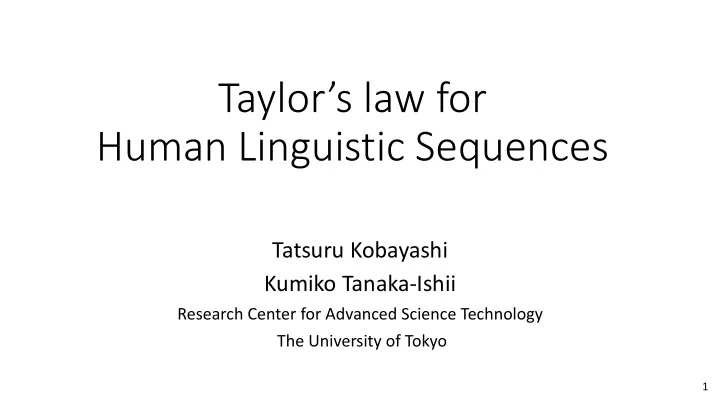

Taylor’s law for Human Linguistic Sequences Tatsuru Kobayashi Kumiko Tanaka-Ishii Research Center for Advanced Science Technology The University of Tokyo 1
Power laws of natural language 1. Vocabulary Population • Zipf’s law • Heaps’ law For “Moby Dick” 2. Burstiness ⇐ About how the words are aligned Words occur in clusters These can be analyzed through power laws Occurrences of words fluctuate Today’s talk is about quantifying the degree of fluctuation. How these could be useful will be presented at the end. 2
Fluctuation underlying text Any words (any word, any set of words) occur in clusters Occurrences of rare words in Moby Dick (below 3162th) 2500th 2000th Two ways of analysis • Fluctuation analysis • Long range correlation → weaknesses 3
Fluctuation underlying text → Look at variance in Δ𝑢 Any words (any word, any set of words) occur in clusters Occurrences of rare words in Moby Dick (below 3162th) Δ𝑢 Variance is larger when events are clustered vs. random • Fluctuation Analysis (Ebeling 1994) Two ways of analysis variance w.r.t. Δ𝑢 • Fluctuation analysis • Taylor’s analysis Our achievements • Long range correlation variance w.r.t. mean 4
Taylor’s law (Smith, 1938; Taylor, 1961) Power law between standard deviation and mean of event occurrences within (space or) time Δ𝑢 𝜏 ∝ 𝜈 ' Empirically 0.5 ≤ 𝛽 ≤ 1.0 (but 𝛽 < 0.5 is of course possible, too) Empirically known to hold in vast fields (Eisler, 2007) ecology, life science, physics, finance, human dynamics … The only application to language is Gerlach & Altmann (2014) ← not really Taylor analysis We devised a new method based on the original concept of Taylor’s law 5
� Our method Word sequence (text) 𝑥 0 𝑥 1 𝑥 0 𝑥 1 …………… Δ𝑢 Δ𝑢 1 For every word kind 𝑥 C ∈ 𝑋 4 Estimate 𝛽 using the least squares count its number of occurrence method in log scale within given length Δ𝑢 . 𝑑̂, 𝛽 5 = argmin =,' 𝜗 𝑑, 𝛽 , 2 Obtain mean 𝜈 C and E 1 standard deviation 𝜏 C of 𝑥 C . ' 1 𝜗 𝑑, 𝛽 = 𝑋 @ log 𝜏 C − log 𝑑𝜈 C . CF0 3 Plot 𝜈 C and 𝜏 C for all words. 6
Taylor’s law of natural language ‘Moby Dick’ English, 250k words, vocabulary size 20k words Taylor’s law in log scale Fluctuated - Here, Δ𝑢 ≈ 5000 . - Every point is a word kind - Estimated Taylor exponent 𝛽 = 0.57 . - Taylor exponent 𝛽 corresponds to gradient of log 𝜈 - log 𝜏 plot. Frequent 7
Taylor’s law of natural language Keywords ‘Moby Dick’ (English)’s Fluctuated Taylor’s law in log scale Functional words Frequent 8
Theoretical analysis of the exponent Empirically 0.5 ≤ 𝛽 ≤ 1.0 𝛽 = 0.5 if all words are independent and identically distributed (i.i.d.). Shuffled ‘Moby Dick’ Δ𝑢 ≈ 5000 . Taylor Exponent 𝛽 = 0.5 because shuffled text is equivalent to i.i.d. process. 9
Theoretical analysis of the exponent 𝛽 = 1.0 if words always co-occur with the same proportion. ex) Suppose that 𝑋 = {𝑥 0 , 𝑥 1 } , and 𝑥 1 occurs always twice as 𝑥 0 … … … 𝑥 0 : 17, 𝑥 1 : 34 𝑥 0 : 3, 𝑥 1 : 6 𝐦𝐩𝐡 𝝉 gradient Δ𝑢 𝛽 = 1 𝑥 1 ⟹ 𝜈 1 = 2𝜈 0 , 𝜏 1 = 2𝜏 0 log 2 𝑥 0 ⟹ 𝜏 ∝ 𝜈 𝐦𝐩𝐡 𝝂 log 2 10
Taylor’s law for other data Programming source code Child directed speech Lisp, crawled and parsed Thomas, English, CHILDES 450k words (8.2k diff. words) 3.7m words (160k diff. words) dear this platform truck insert up xload and things unless let hand 11
Datasets Kind Languages Number Average size Example of texts Gutenberg & Aozora 14(En, Fr, …) 1142 311,483 ‘Moby Dick’ (Long, single author) ‘Les Miserables’ Newspapers 3 (En,Zh,Ja) 4 580,488,956 WSJ Tagged Wiki 1 (En+tag) 1 14,637,848 enwiki8 CHILDES 10(En, Fr, …) 10 193,434 Thomas (English) Music - 12 135,993 Matthäus (Bach) Program Codes 4 4 34,161,018 C++, Lisp, Haskell, Python 12
Taylor exponents of various data kind Written Texts 0.80 mean 𝛽 = 0.58 Single author texts 0.70 𝛽 Random 0.79 0.79 Texts 0.68 0.60 0.63 𝛽 = 0.50 Other data 0.50 𝛽 ≥ 0.63 13 None of the real texts showed the exponent 0.5
Summary thus far • Taylor’s law holds in vast fields including natural/social science • Taylor’s law also holds in languages and other linguistic related sequential data • Taylor exponent shows the degree of co-occurrence among words • Taylor exponent 𝛽 differs among text categories (No such quality for Zipf’s law, Heaps’ law) How can our results be useful? ⇒ Do machine generated texts produce 𝛽 > 0.5 ? 14
Machine generated text by n -grams bigrams of Moby Dick 15
Machine generated texts by character-based LSTM language model Learning: Shakespeare by naive setting Stacked LSTM (3 LSTM layers) Generation: Probabilistic generation of succeeding characters Distribution of following character (2 million characters) LSTM 256 nodes State-of the art models present different results 128 preceding characters (in another paper) 16
Texts generated by machine translation Les Miserables translated by Les Miserables Google translator (in English) (original, French) Fluctuation that derives from the context is provided by the source text 17
Conclusion • Taylor’s law holds in vast fields including natural/social science • Taylor’s law also holds in languages and other linguistic related sequential data • Taylor exponent shows the degree of co-occurrence among words • Taylor exponent 𝛽 differs among text categories (No such quality for Zipf’s law, Heaps’ law) How can our results be useful? ⇒ Do machine generated texts produce 𝛽 > 0.5 ? • The nature of 𝛽 > 0.5 : context and long memory ← one limitation of CL • Taylor analysis would possibly evaluate machine outputs • Knowing mathematical characteristic of texts serve for language engineering 18
Thank you 19
Recommend
More recommend